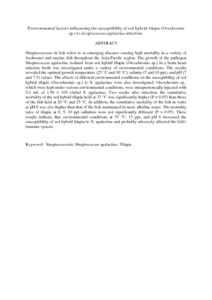Citation
Alsaid, Milud and Mohd Daud, Hassan and Mohamed Mustapha, Noordin and Bejo, Siti Khairani and Mohamed, Yasser and Abuseliana, Ali Farag
(2013)
Environmental factors influencing the susceptibility of red hybrid tilapia (Orechromis sp.) to Streptococcus agalactiae infection.
Advanced Science Letters, 19 (12).
pp. 3600-3604.
ISSN 1936-6612; ESSN: 1936-7317
Abstract
Streptococcosis in fish refers to re-emerging diseases causing high mortality in a variety of freshwater and marine fish throughout the Asia-Pacific region. The growth of the pathogen Streptococcus agalactiae isolated from red hybrid tilapia (Oreochromis sp.) in a brain heart infusion broth was investigated under a variety of environmental conditions. The results revealed the optimal growth temperature (25 °C and 30 °C), salinity (5 and 10 ppt), and pH (7 and 7.5) values. The effects of different environmental conditions on the susceptibility of red hybrid tilapia (Oreochromis sp.) to S. agalactiae were also investigated. Oreochromis sp., which were kept under various environmental conditions, were intraperitoneally injected with 0.1 mL of 1.56 × 105 cfu/ml S. agalactiae. Two weeks after infection, the cumulative mortality of the red hybrid tilapia held at 33 °C was significantly higher (P < 0.05) than those of the fish held at 20 °C and 25 °C. In addition, the cumulative mortality of the fish in water at pH 6 was also higher than that of the fish maintained in more alkaline water. The mortality rates of tilapia at 0, 5, 10 ppt salinities were not significantly different (P > 0.05). These results indicate that environmental conditions at 33 °C, 15 ppt, and pH 6 increased the susceptibility of red hybrid tilapia to S. agalactiae and probably adversely affected the fish's immune system.
Download File
![[img]](http://psasir.upm.edu.my/25706/1.hassmallThumbnailVersion/Environmental%20factors%20influencing%20the%20susceptibility%20of%20red%20hybrid%20tilapia.pdf)  Preview |
|
PDF (Abstract)
Environmental factors influencing the susceptibility of red hybrid tilapia.pdf
Download (85kB)
| Preview
|
|
Additional Metadata
Actions (login required)
 |
View Item |

